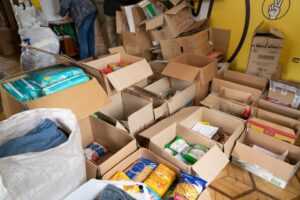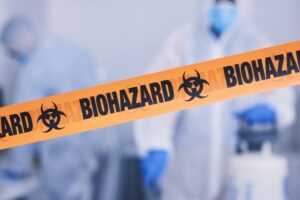When a traumatic event occurs at your place of business, the emotional shock is immediate. As a business owner or manager, your first concern is for your people. But quickly, practical concerns follow. Beyond the tragedy itself, you are left with a situation that is hazardous, overwhelming, and requires immediate, specialized attention. This is not a task for your internal team. Standard cleaning services are not equipped, trained, or licensed for this work. This is where professional trauma scene restoration becomes essential. It’s a detailed, scientific process that protects your employees, ensures your compliance, and allows your business to safely move forward.
What Is Trauma Scene Restoration?
Many people misunderstand what trauma scene restoration truly involves. It is not simply cleaning what is visible. It is a comprehensive, scientific service designed to address the biohazardous materials left behind after events like an unattended death, a violent crime, an industrial accident, or other traumatic incidents. These scenes often contain blood, bodily fluids, and other potential pathogens. Certified technicians follow strict protocols to contain the area, clean, disinfect, and deodorize every affected surface. The goal is to return the space to a completely safe, pre-incident condition, eliminating all health risks, both seen and unseen.
The Immediate Risks for Businesses
For a business owner, the aftermath of a trauma scene presents unique and serious challenges. Attempting to manage this internally or using a standard janitorial service creates significant liability. The risks are too high.
- Health and Safety: This is the primary concern. Bloodborne pathogens like Hepatitis B, Hepatitis C, and HIV can survive on surfaces for days or even weeks. Improper cleaning protocols expose your staff, customers, and vendors to serious, life-altering infection risks.
- Legal and Compliance: The Occupational Safety and Health Administration (OSHA) has strict regulations regarding workplace exposure to biohazards. Businesses must have an exposure control plan. Failure to comply can result in severe fines and legal action.
- Business Interruption: An unsafe environment cannot be open to the public or used by employees. Every hour the site remains contaminated is an hour of lost productivity. The longer the cleanup takes, the longer your business suffers from downtime and revenue loss.
- Reputational Damage: How your business handles a tragedy matters. A botched cleanup, or the perception that safety was compromised, can permanently damage your brand’s reputation with the public and destroy employee morale.
The Professional Restoration Process
A certified trauma scene restoration team follows a meticulous, multi-step process to guarantee safety. This isn’t a “one-size-fits-all” approach; it’s a careful procedure.
- Assessment and Containment: Technicians arrive in full personal protective equipment (PPE). They assess the situation, identify all affected areas (including those not immediately obvious), and establish a containment zone. This involves using plastic sheeting and negative air pressure to prevent airborne pathogens from spreading.
- Cleaning and Disinfection: This phase removes all visible biological matter. Technicians then use special, EPA-approved, hospital-grade disinfectants to kill 100% of pathogens. This goes far beyond wiping; it involves treating porous materials, sub-flooring, and hidden crevices.
- Deodorization and Restoration: Traumatic events often leave behind strong, distressing odors. Professionals use advanced deodorization techniques, such as ozone generators or thermal foggers, to neutralize odors at their source rather than just masking them.
- Verification and Waste Disposal: After cleaning, the team may use scientific testing to verify that the area is free of pathogens. Finally, all biohazardous waste—including contaminated items and cleaning materials—is packaged in labeled red bags, transported, and disposed of according to strict federal and state laws.
Why DIY Cleaning Is Not an Option
The instinct to “clean up” quickly and quietly is understandable, but it is dangerous for businesses. Asking your existing staff or a standard janitorial service to handle a trauma scene restoration is a critical mistake. They lack the specialized training, equipment (PPE), and industrial-grade chemicals required by law. Household bleach is not effective for this level of contamination. Furthermore, the emotional toll of this task on untrained employees can be severe, causing psychological distress and re-traumatization. This approach almost guarantees that microscopic hazards will be missed, leaving your business liable for future health issues.

Benefits of Hiring a Professional Like ZBM, Inc.
Partnering with a professional trauma scene restoration company like ZBM, Inc. provides critical benefits when your business needs it most. You get speed; experts work efficiently to minimize your downtime and get you operational again. You get thoroughness; we guarantee the site is safe, disinfected, and compliant with all regulations. We also provide discretion and compassion, understanding the sensitive nature of the event and working respectfully around your team. Ultimately, it provides peace of mind. You receive documentation that the job was done correctly by certified experts, protecting your business, your people, and your reputation.
Your Partner for Trauma Scene Restoration in Dodge & Jefferson County, WI
You do not have to manage this difficult situation alone. If your business needs professional and compassionate trauma scene restoration, ZBM, Inc. is here to help. We serve businesses throughout Dodge & Jefferson County, ensuring your property is returned to a safe state quickly and discreetly. We are available 24/7 to respond to your needs. Learn more about our comprehensive biohazard cleanup services by contacting us today.


